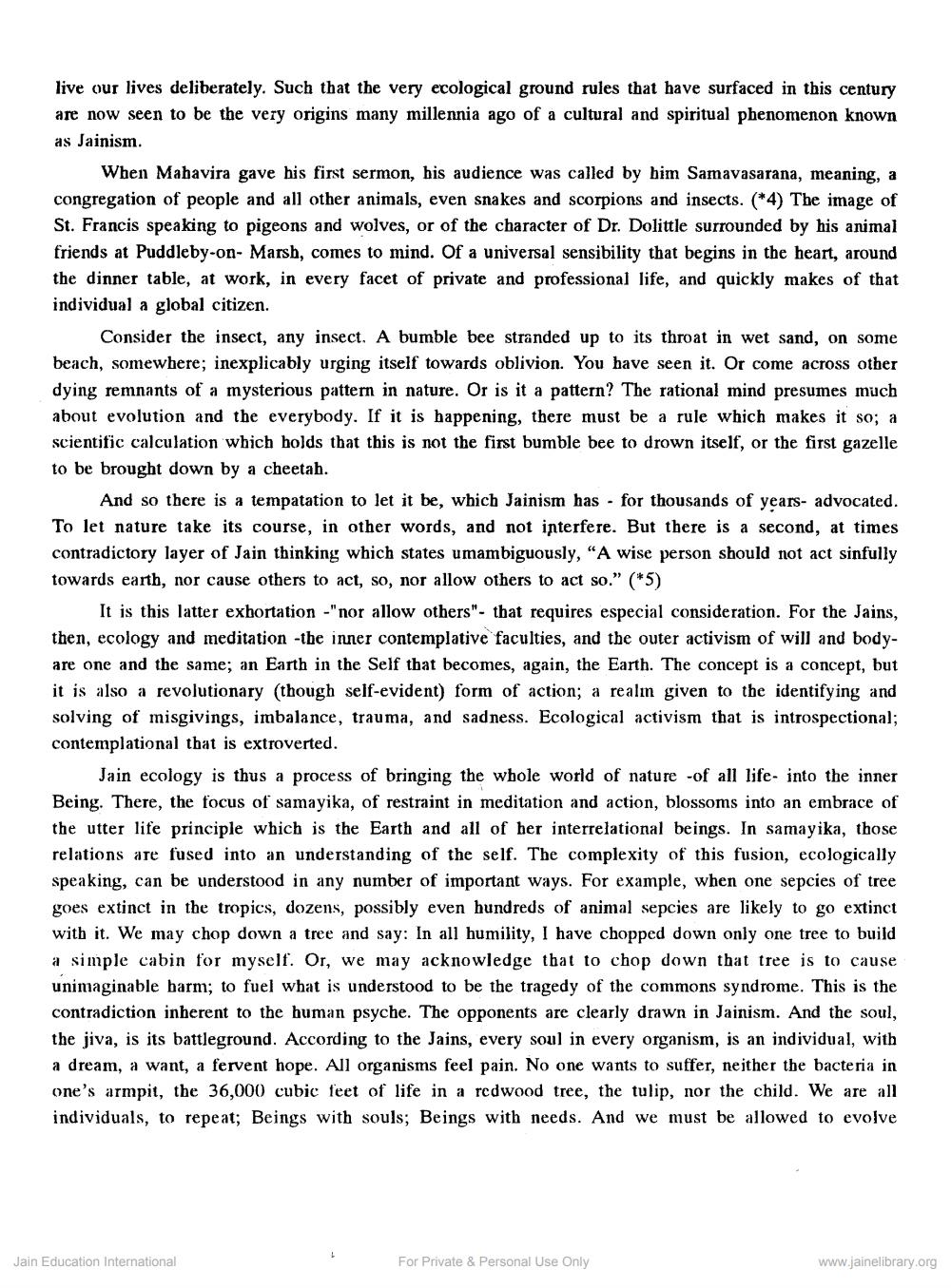________________
live our lives deliberately. Such that the very ecological ground rules that have surfaced in this century are now seen to be the very origins many millennia ago of a cultural and spiritual phenomenon known as Jainism.
When Mahavira gave his first sermon, bis audience was called by bim Samavasarana, meaning, a congregation of people and all other animals, even snakes and scorpions and insects. (*4) The image of St. Francis speaking to pigeons and wolves, or of the character of Dr. Dolittle surrounded by his animal friends at Puddleby-on- Marsh, comes to mind. Of a universal sensibility that begins in the heart, around the dinner table, at work, in every facet of private and professional life, and quickly makes of that individual a global citizen.
Consider the insect, any insect. A bumble bee stranded up to its throat in wet sand, on some beach, somewhere; inexplicably urging itself towards oblivion. You have seen it. Or come across other dying remnants of a mysterious pattern in nature. Or is it a pattern? The rational mind presumes much about evolution and the everybody. If it is happening, there must be a rule which makes it so; a scientific calculation which holds that this is not the first bumble bee to drown itself, or the first gazelle to be brought down by a cheetah.
And so there is a tempatation to let it be, which Jainism has - for thousands of years- advocated. To let nature take its course, in other words, and not interfere. But there is a second, at times contradictory layer of Jain thinking which states umambiguously, "A wise person should not act sinfully towards earth, nor cause others to act, so, nor allow others to act so." (*5)
It is this latter exhortation -"nor allow others"- that requires especial consideration. For the Jains, then, ecology and meditation -the inner contemplative faculties, and the outer activism of will and bodyare one and the same; an Earth in the Self that becomes, again, the Earth. The concept is a concept, but it is also a revolutionary (though self-evident) form of action; a realm given to the identifying and solving of misgivings, imbalance, trauma, and sadness. Ecological activism that is introspectional; contemplational that is extroverted.
Jain ecology is thus a process of bringing the whole world of nature -of all life- into the inner Being. There, the focus of samayika, of restraint in meditation and action, blossoms into an embrace of the utter life principle which is the Earth and all of her interrelational beings. In samayika, those relations are fused into an understanding of the self. The complexity of this fusion, ecologically speaking, can be understood in any number of important ways. For example, when one sepcies of tree goes extinct in the tropics, dozens, possibly even hundreds of animal sepcies are likely to go extinct with it. We may chop down a tree and say: In all humility, I have chopped down only one tree to build a simple cabin for myself. Or, we may acknowledge that to chop down that tree is to cause unimaginable barm; to fuel what is understood to be the tragedy of the commons syndrome. This is the contradiction inherent to the human psyche. The opponents are clearly drawn in Jainism. And the soul, the jiva, is its battleground. According to the Jains, every soul in every organism, is an individual, with a dream, a want, a fervent hope. All organisms feel pain. No one wants to suffer, neither the bacteria in one's armpit, the 36,000 cubic feet of life in a redwood tree, the tulip, nor the child. We are all individuals, to repeat; Beings with souls; Beings with needs. And we must be allowed to evolve
Jain Education International
For Private & Personal Use Only
www.jainelibrary.org




